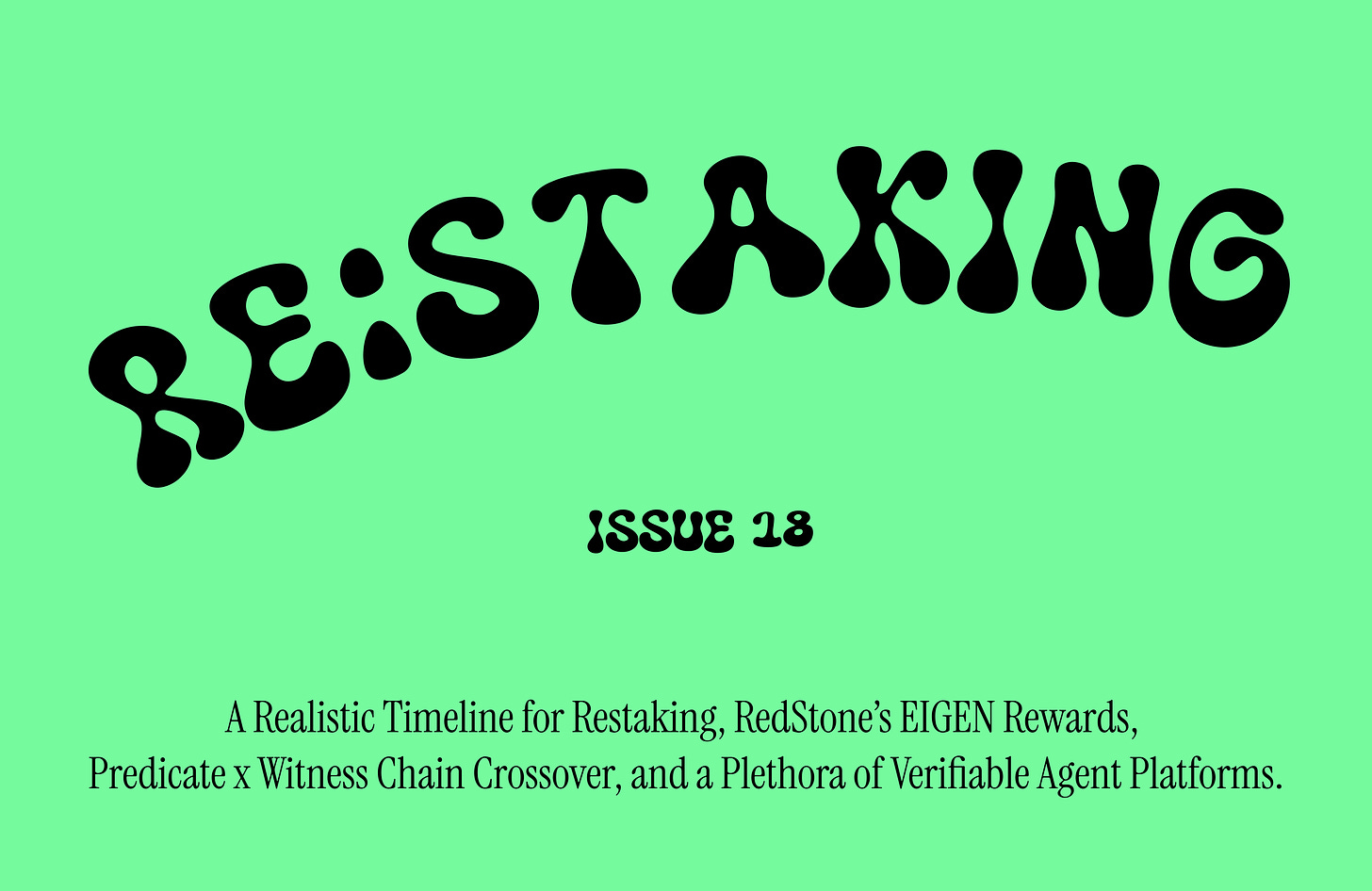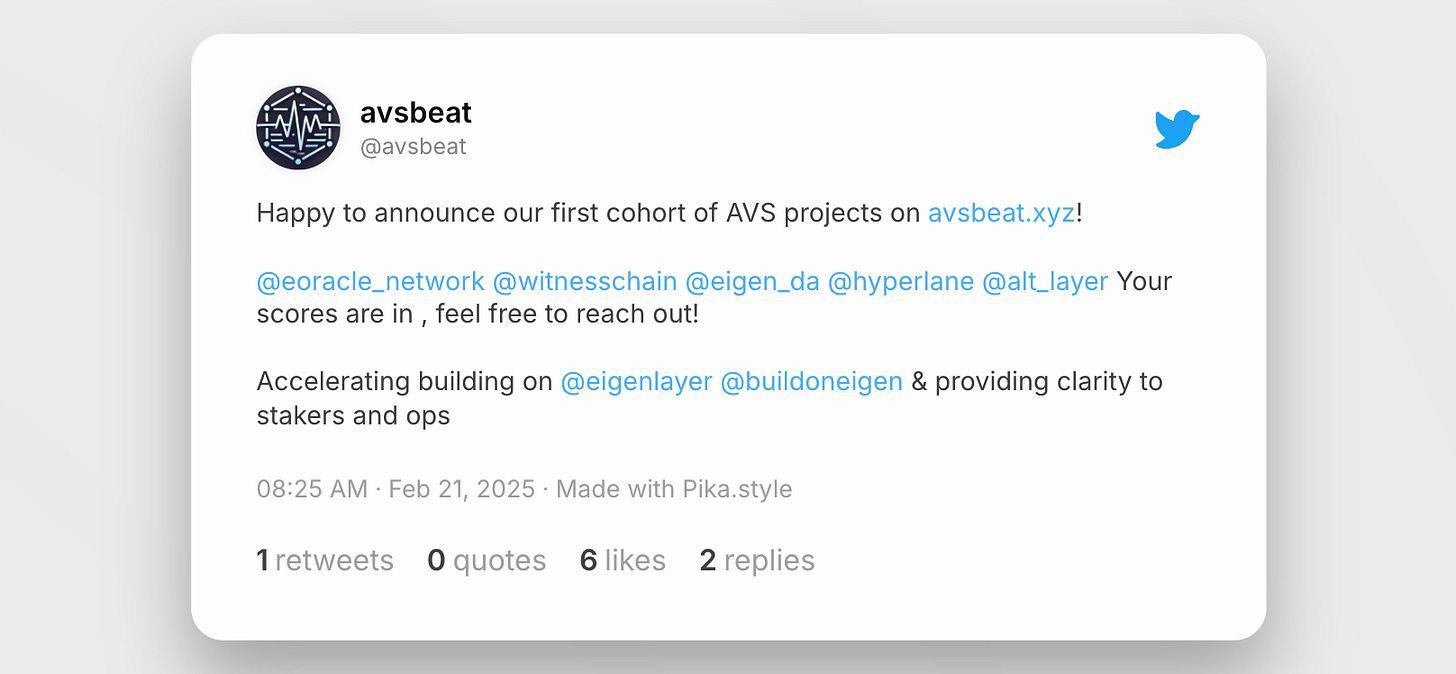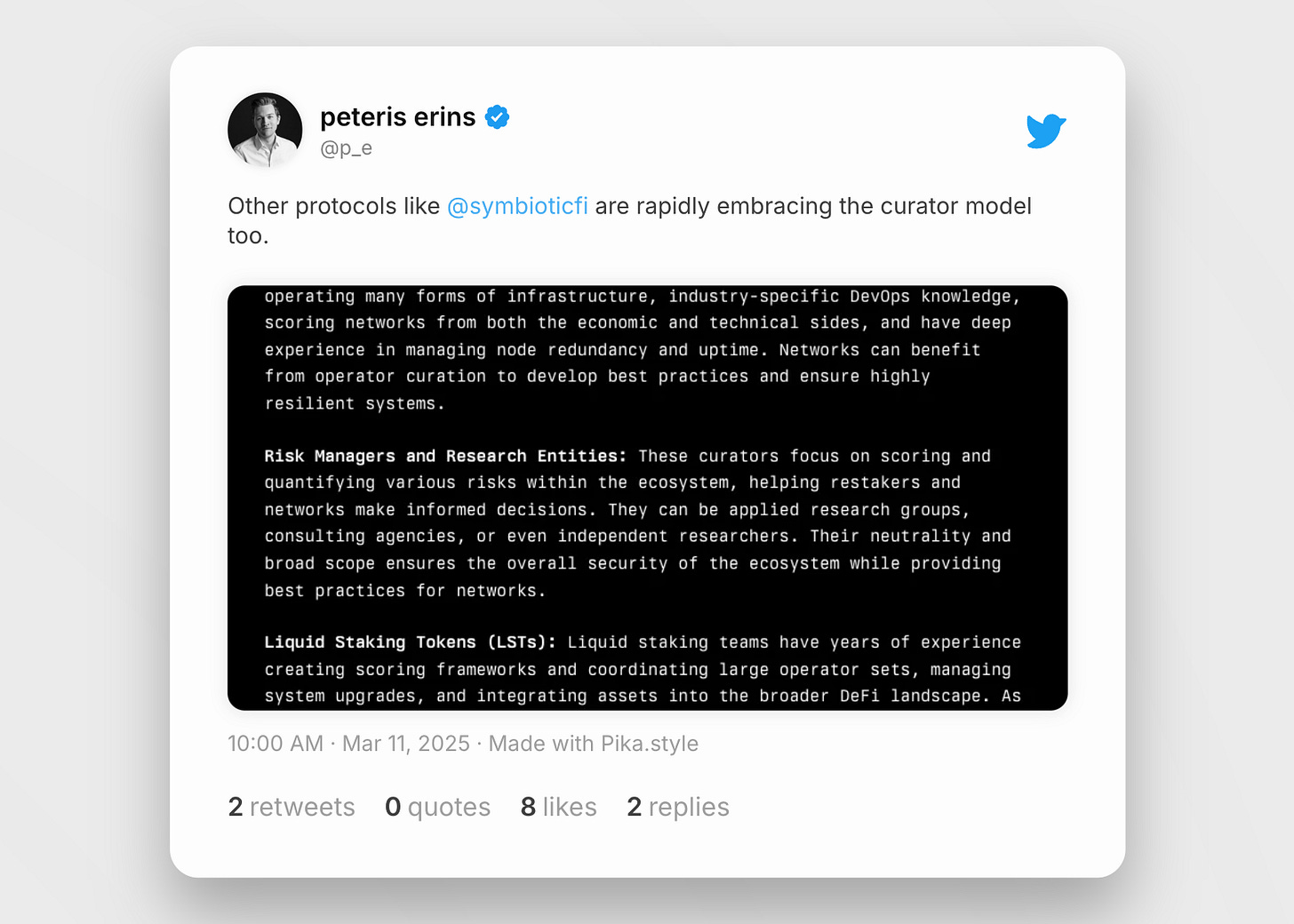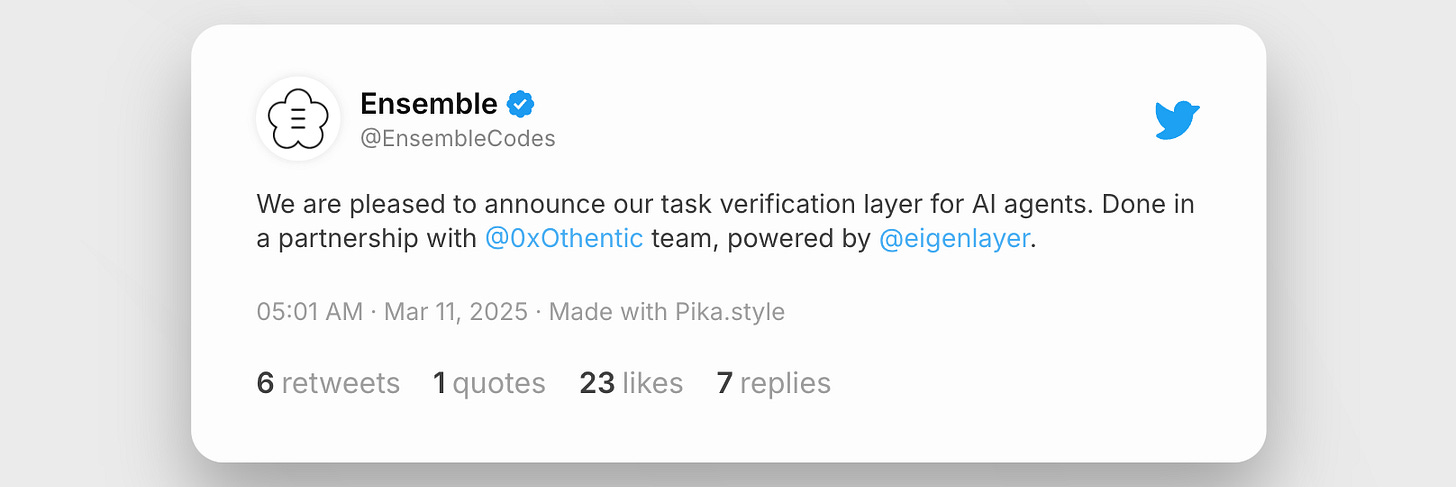Re:Staking Weekly #18
A Realistic Timeline for Restaking, RedStone’s EIGEN Rewards, Predicate x Witness Chain Crossover, and a Plethora of Verifiable Agent Platforms.
Welcome to Issue #18 of Re:Staking Weekly! 👋
This week, we're mapping out a realistic timeline for restaking. The sector has spent too much time focusing on features—rewards, slashing, and more—but not enough on adoption. It's time to shift the conversation and chart a path toward a future where adoption is high and revenue is strong.
Also in this issue: RedStone’s EIGEN rewards, Predicate and Witness Chain crossover, L2beat-style scoring for AVSs, and a plethora of verifiable agent platforms.
Let’s dive in! 🚀
The Realistic Timeline for Restaking
Over the past year, I’ve consistently seen people question the purpose of restaking and the progress EigenLayer has made. Some of this is just FUD, but I also think it reflects a deeper concern — some aspects of restaking aren’t yet delivering what people expect.
A key reason for this skepticism is the disconnect between what’s being presented and what’s being experienced by users. EigenLayer has done an undeniably great job in marketing restaking, announcing feature releases, and onboarding AVSs—perhaps too good of a job. This creates a contrast: while the ecosystem sees clear momentum, what people actually care about is lagging behind — seeing their staked assets put to real work and generating meaningful rewards. More importantly, they want to see real revenue flowing from AVSs.
That’s where the big questions arise:
Does restaking actually generate economic value?
Is EigenLayer (and similar protocols) building the right products to drive revenue creation?
Of course, I believe restaking creates economic value—if it didn’t, we wouldn’t be here. I’ve written before about its economies of scale, and I do think EigenLayer and other protocols are building the right products. But where we can improve is in communicating the timeline more effectively.
We need to move away from a timeline filled with feature releases and focus on a timeline of real adoption. That’s what we’re going to break down today.
The Timeline of Adoption
The timeline of adoption can be broken down into three stages — much like the Lean Startup framework:
Shipping the minimum viable product (MVP)
Finding the first set of customers
Scaling
What we’re experiencing today is a misalignment in what qualifies as the true MVP of restaking. Just like adding a camera and a powerful computer to your car doesn’t mean it can drive itself, simply launching rewards and slashing doesn’t mean restaking is fully functional.
The Minimum Viable Product of Restaking
The first real milestone is when a single AVS completes the full feature loop—real rewards and real slashing.
Real is the key word here. Some rewards exist today, but they’re minimal, and slashing remains largely theoretical. To some extent, you want the rewards to be exceptional and the pain to be painful. That’s why I don’t think mechanisms like operator ejection or redistribution — where the stake isn’t actually lost — are going to cut it.
In the early stages, slashing carries symbolic weight. It signals that staked assets carry real risk, forcing restakers to think critically about where they allocate capital and pushing AVSs to treat TVL as something more than free money.
The true MVP of restaking isn’t just about turning on features—it requires both real incentives and real penalties. Until that happens, restaking remains incomplete.
The Imitation Game
Once the first AVS successfully establishes a working economic model, others will copy. Right now, no one knows the optimal parameters for restaking. In this uncertainty, most projects are waiting for someone else to experiment first.
The moment one AVS successfully implements a full restaking loop, it sets a precedent — a baseline that others can imitate. I believe we need at least five AVSs adopting similar models before the imitation phase truly takes off.
The Scaling
Once the first few AVSs standardize their economic models, momentum kicks in. This is when restaking moves from an experimental concept to a viable, long-term mechanism in crypto, allowing scale economies to take over. The first two milestones are the hardest — until they’re reached, I wouldn’t even consider restaking a serious contender in the long-term crypto narrative.
Where Are We Now?
Right now, we’re still a long way from reaching the first milestone — meaning restaking is still pre-product-market fit.
I actually agree with most of the critics — the current projects integrating with restaking don’t yet prove real revenue generation. They’re experiments, not economic engines. And that’s fine! The skepticism isn’t misplaced. It’s just early.
The real question is whether we’re on track to cross these milestones. Due to turbulence on Holesky, the slashing feature is now projected to go live on mainnet in early April. On testnet, more than a month after the release of slashing and operator sets, only around two dozen AVSs — out of approximately 1,500 registered — have tested the idea, and meaningful data remains scarce.
Given this pace, I’d estimate the first AVS to complete the full feature loop sometime in Q2 or Q3 of this year — which is already ambitious. The second milestone, where multiple AVSs adopt the model, could realistically stretch into Q4 or even Q1 2026. That said, once the first milestone is reached, adoption will likely accelerate.
Until then, rather than just waiting and hoping, the best thing we can do is stay focused on building toward that first real test.
News Bites
You can now earn $EIGEN rewards if you have restaked into the RedStone AVS.
Listen to Eigen Foundation CEO Robert Drost’s presentation at Stanford, where he discusses new verifiable services and the evolution of computing paradigms.
Will we see more AVS crossovers? Witness Chain and Predicate have joined forces to introduce geolocation-based compliance pre-transaction checks.
Lagrange introduces its zkML libraries, designed to generate verifiable AI inference proofs.
Check out the new AVSbeat website for L2beat-style subjective AVS ratings across parameters such as slashing, interoperability, rewards, and more. Built by the team members of Opacity and Breadchain.
We have discussed the need for strategy curators given the overwhelming number of yield possibilities within the restaking ecosystem. Peteris shared an insightful thread on the necessity of curators and the different types of curator roles.
A Plethora of Verifiable Agent Platforms
Mother is integrating restaking. It is an AI agent platform that enables its agents to be secured by ETH.
Ensemble is an agent platform with a built-in AVS for agent task verification, built on the Othentic stack.
Autonome is following AltLayer’s playbook, enabling AI agents to be restaked and secured by a diverse range of assets.
That's it for this week's newsletter! As always, feel free to send us a DM or comment directly below with your thoughts or questions.
If you want to catch up with the latest news in the restaking world, give our curated X list a follow!
See you next week and thanks for reading,













